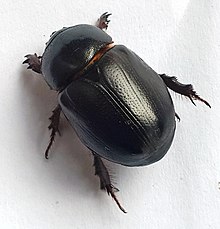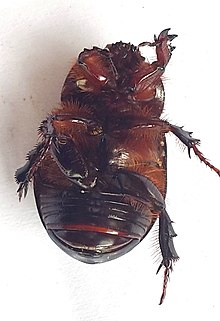| Heteronychus arator | |
|---|---|

| |

| |
|
Scientific classification
| |
| Domain: | Eukaryota |
| Kingdom: | Animalia |
| Phylum: | Arthropoda |
| Class: | Insecta |
| Order: | Coleoptera |
| Family: | Scarabaeidae |
| Genus: | Heteronychus |
| Species: | H. arator
|
| Binomial name | |
| Heteronychus arator (
Fabricius, 1775)
| |
Heteronychus arator (hetero+onychus = 'variable claw', arator = 'ploughman') is a species of beetle in the subfamily Dynastinae (the rhinoceros beetles). It is commonly called African black beetle or black lawn beetle. [1] It is native to Africa and it is an introduced species in Australia, Norfolk Island and the North Island of New Zealand. [2]
Morphology
It is a shiny black (or dark reddish brown) oval-shaped beetle 12-15 millimeters long. The head lacks a carina or tubercles, unlike some other scarabs. The clypeus is truncate with distinct lateral margins, and dentate with a denticle in the middle. Each mandible has 2-3 teeth on the outer edge and is visible when looking at the beetle from above. Each antenna is 10-segmented and ends in a 3-segmented club. On the underside of the head is a mentum with a rounded apex. Each eye is partially split by a glabrous (smooth) ocular canthus. The pronotum is smooth, convex and lacks punctures. The elytra have rows of shallow striae. The propygidium (dorsal plate of the second-last abdominal segment) has a pair of stridulatory bands. The hind legs have tibiae with truncate apices. All legs end in simple tarsal claws. [3]
Diet
Adults feed on stems of plants at or just below ground level, while larvae feed on organic matter and roots in soil. [1] This species may damage lawns and other turf, especially during the summer, as well as many crop plants, garden flowers, [4] trees and shrubs. [1] It prefers some plants over others: larvae gain more weight when feeding on ryegrass than on white clover or lotus. [5]
Diseases
This species is infected by a small RNA virus. This virus develops in the cytoplasm of gut and fat body cells. It can also infect larvae of greater wax moth ( Galleria mellonella) and some other insects, but cannot infect mice. [6]
References
- ^ a b c African black beetle (Heteronychus arator) - pest of viticulture. Archived 2011-03-20 at the Wayback Machine Western Australia Department of Agriculture. 2005.
- ^ "Heteronychus arator (African black beetle)". CABI Compendium. 2022. doi: 10.1079/cabicompendium.27067. S2CID 253615399. Retrieved 2022-12-16.
- ^ "Heteronychus arator". keys.lucidcentral.org. Retrieved 2022-12-16.
- ^ African Black Beetle - Heteronychus arator. iLandscape.com.au, April 3, 2012.
- ^ King, P. D. (1977). "Effect of plant species and organic matter on feeding behaviour and weight gain of larval black beetle, Heteronychus arator (Coleoptera: Sacrabaeidae)". New Zealand Journal of Zoology. 4 (4): 445–448. doi: 10.1080/03014223.1977.9517968. ISSN 0301-4223.
- ^ Longworth, J. F.; Carey, G. P. (1976-10-01). "A Small RNA Virus with a Divided Genome from Heteronychus arator (F.) [Coleoptera: Scarabaeidae]". Journal of General Virology. 33 (1): 31–40. doi: 10.1099/0022-1317-33-1-31. ISSN 0022-1317. PMID 978185.
Further reading
-
 Media related to
Heteronychus arator at Wikimedia Commons
Media related to
Heteronychus arator at Wikimedia Commons -
 Data related to
Heteronychus arator at Wikispecies
Data related to
Heteronychus arator at Wikispecies
| Heteronychus arator | |
|---|---|

| |

| |
|
Scientific classification
| |
| Domain: | Eukaryota |
| Kingdom: | Animalia |
| Phylum: | Arthropoda |
| Class: | Insecta |
| Order: | Coleoptera |
| Family: | Scarabaeidae |
| Genus: | Heteronychus |
| Species: | H. arator
|
| Binomial name | |
| Heteronychus arator (
Fabricius, 1775)
| |
Heteronychus arator (hetero+onychus = 'variable claw', arator = 'ploughman') is a species of beetle in the subfamily Dynastinae (the rhinoceros beetles). It is commonly called African black beetle or black lawn beetle. [1] It is native to Africa and it is an introduced species in Australia, Norfolk Island and the North Island of New Zealand. [2]
Morphology
It is a shiny black (or dark reddish brown) oval-shaped beetle 12-15 millimeters long. The head lacks a carina or tubercles, unlike some other scarabs. The clypeus is truncate with distinct lateral margins, and dentate with a denticle in the middle. Each mandible has 2-3 teeth on the outer edge and is visible when looking at the beetle from above. Each antenna is 10-segmented and ends in a 3-segmented club. On the underside of the head is a mentum with a rounded apex. Each eye is partially split by a glabrous (smooth) ocular canthus. The pronotum is smooth, convex and lacks punctures. The elytra have rows of shallow striae. The propygidium (dorsal plate of the second-last abdominal segment) has a pair of stridulatory bands. The hind legs have tibiae with truncate apices. All legs end in simple tarsal claws. [3]
Diet
Adults feed on stems of plants at or just below ground level, while larvae feed on organic matter and roots in soil. [1] This species may damage lawns and other turf, especially during the summer, as well as many crop plants, garden flowers, [4] trees and shrubs. [1] It prefers some plants over others: larvae gain more weight when feeding on ryegrass than on white clover or lotus. [5]
Diseases
This species is infected by a small RNA virus. This virus develops in the cytoplasm of gut and fat body cells. It can also infect larvae of greater wax moth ( Galleria mellonella) and some other insects, but cannot infect mice. [6]
References
- ^ a b c African black beetle (Heteronychus arator) - pest of viticulture. Archived 2011-03-20 at the Wayback Machine Western Australia Department of Agriculture. 2005.
- ^ "Heteronychus arator (African black beetle)". CABI Compendium. 2022. doi: 10.1079/cabicompendium.27067. S2CID 253615399. Retrieved 2022-12-16.
- ^ "Heteronychus arator". keys.lucidcentral.org. Retrieved 2022-12-16.
- ^ African Black Beetle - Heteronychus arator. iLandscape.com.au, April 3, 2012.
- ^ King, P. D. (1977). "Effect of plant species and organic matter on feeding behaviour and weight gain of larval black beetle, Heteronychus arator (Coleoptera: Sacrabaeidae)". New Zealand Journal of Zoology. 4 (4): 445–448. doi: 10.1080/03014223.1977.9517968. ISSN 0301-4223.
- ^ Longworth, J. F.; Carey, G. P. (1976-10-01). "A Small RNA Virus with a Divided Genome from Heteronychus arator (F.) [Coleoptera: Scarabaeidae]". Journal of General Virology. 33 (1): 31–40. doi: 10.1099/0022-1317-33-1-31. ISSN 0022-1317. PMID 978185.
Further reading
-
 Media related to
Heteronychus arator at Wikimedia Commons
Media related to
Heteronychus arator at Wikimedia Commons -
 Data related to
Heteronychus arator at Wikispecies
Data related to
Heteronychus arator at Wikispecies